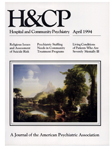A Clinical Profile of Patients Affected by State Regulation of Benzodiazepine Prescriptions
Abstract
In 1989 New York State extended regulation of controlled substances to benzodiazepines. To study the effects on patients, the authors examined characteristics of patients who came to a psychiatric outpatient clinic seeking benzodiazepines during the year after the regulation took effect.
Methods: Demographic and clinical characteristics of 44 patients who sought benzodiazepines were compared with those of 297 other patients evaluated at the clinic during the same period. Compliance with clinic treatment recommendations by patients who sought benzodiazepines was assessed at six-month follow-up.
Results: Patients seeking benzodiazepines were predominantly impoverished minority women with a diagnosis of a mood disorder or anxiety disorder. Most were not drug or alcohol abusers. After evaluation at the clinic, nearly half received prescriptions for antidepressant medications instead of benzodiazepines. Although the patients seeking benzodiazepines bad many psychosocial problems, they bad poor compliance with clinic psychotherapy interventions.
Conclusions: Regulation of benzodiazepine prescriptions appeared to significantly disrupt the treatment of some patients and to encourage them to seek treatment in a psychiatric setting. The high frequency of mood disorders among these patients suggests that some patients may have been misdiagnosed earlier as having anxiety disorder and raises questions about the appropriateness of their previous use of benzodiazepines.
Access content
To read the fulltext, please use one of the options below to sign in or purchase access.- Personal login
- Institutional Login
- Sign in via OpenAthens
- Register for access
-
Please login/register if you wish to pair your device and check access availability.
Not a subscriber?
PsychiatryOnline subscription options offer access to the DSM-5 library, books, journals, CME, and patient resources. This all-in-one virtual library provides psychiatrists and mental health professionals with key resources for diagnosis, treatment, research, and professional development.
Need more help? PsychiatryOnline Customer Service may be reached by emailing [email protected] or by calling 800-368-5777 (in the U.S.) or 703-907-7322 (outside the U.S.).



